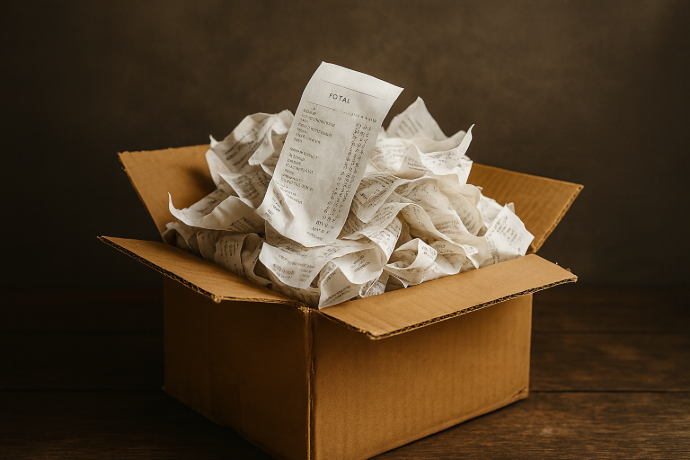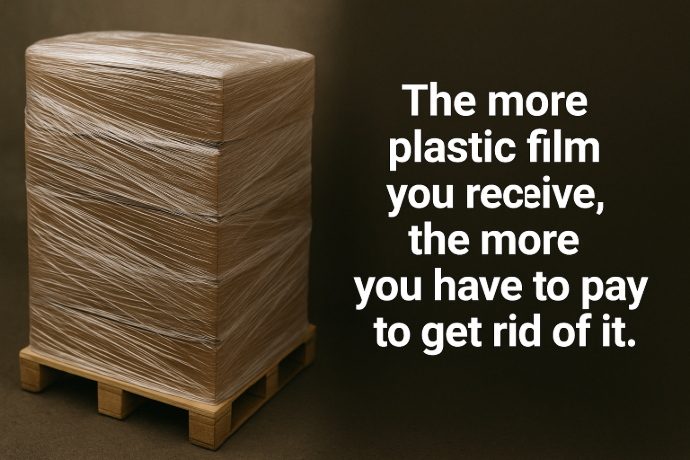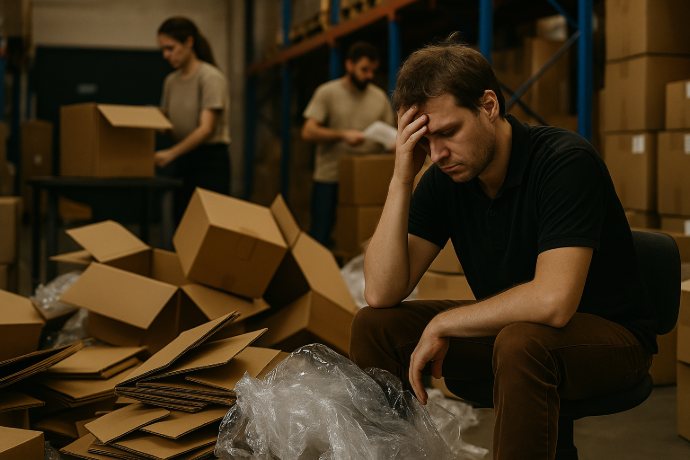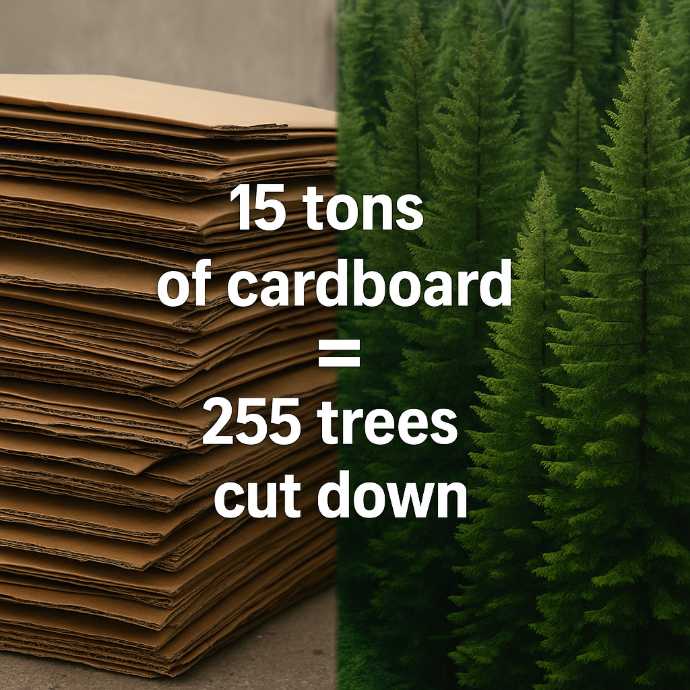SOMMAIRE
Introduction
- Le prix d'achat
- Le coût du déchet
- Les coûts cachés
- La comparaison avec le réutilisable
- L'impact environnemental
Conclusion
Introduction
A single-use package is not just a few cents at purchase.
Behind this apparent cost lies a much heavier reality:
- Tons of waste to manage,
- invisible bills that keep piling up,
- and an environmental impact that comes at a high price.
At Loopipak, we wanted to break down the real costs for a company.
1. Purchase price
The tip of the iceberg
An e-commerce box costs between €0.60 and €3.
An e-commerce box costs between €0.60 and €3. A plastic stretch film for a pallet costs between €1 and €3 per pallet.
These prices may seem low, but multiplied by hundreds or thousands of shipments per week, the bill rises very quickly.
Concrete examples:
- Company A shipping 500 parcels/week (€1 per box) spends €26,000 per year on boxes alone.
- Company B sending 200 pallets/week (€13 per 300 m roll, 7 wraps per pallet) spends €12,620 per year on stretch film alone.

2. The cost of waste
The invisible part of the iceberg
Single-use packaging does not “disappear” for free: it becomes waste that must be collected, transported, sorted, incinerated, or landfilled.
a) The mandatory contribution to collection organizations
In Belgium, the mandatory contribution to collection organizations (FostPlus and Valipac) amounts to:
- €150 for cardboard and €1,285 for PE film with FostPlus
- €20 for cardboard and €63 for PE film with Valipac
You pay a fee to FostPlus if you operate in B2C, to Valipac if you operate in B2B, and to both if your activity covers both.
*https://www.fostplus.be/fr/membres/les-tarifs-point-vert-document environnement
Concrete examples:
- Company A (B2C) shipping 500 parcels/week generates more than 15.6 tonnes of cardboard per year, resulting in a €2,340 annual fee.
- Company B (B2B) wrapping 200 pallets/week produces more than 3 tonnes of plastic per year, i.e. €189 per year in fees.
b) Cost of waste removal and treatment
In Belgium (and across Europe in general):
Cardboard/paper :
This is a secondary raw material sought after by recycling channels.
If the company sorts properly and provides sufficient volumes (compacted bales, palletised cardboard), the collector buys the material → typically between €20 and €60 per tonne, depending on market and quality.
If volumes are too small or poorly sorted, the collector may charge a small collection fee, but overall it is a positive or neutral stream for the company.
Flexible plastic (stretch film, bags, etc.) :
It is much more difficult and costly to recycle (contaminated, few local recycling channels).
Result: the collector charges for taking it back → typically €200–400 per tonne, or €2–4 per 400 L bag.
In most cases, this plastic ends up being incinerated with energy recovery → so it is never remunerated.
What about the logistical and environmental cost of waste transportation?
In Belgium, the selective collection of packaging waste by garbage truck generates around 17 kg of fossil CO₂ per tonne collected in door-to-door collection in Brussels. This figure increases during selective collection rounds, as trucks travel more kilometers before being filled.
The more your company receives products packaged in cardboard, the more you can expect to recover some money through recycling.
But the more stretch film you receive, the more you have to pay to get rid of it.
In short: cardboard earns (a little), plastic always costs.

By way of comparison:
Company A: 15 tonnes of cardboard = the weight of 10 family cars
Company B: 3 tonnes of plastic = the weight of a small delivery truck
And this waste does not move by magic: it is collected and transported by trucks to recycling or incineration centers.
This represents an additional logistical and environmental cost — fuel, emissions, handling time — that does not appear on the invoice but adds to the real cost of single-use.
3. The hidden costs (quantified)
a) Storage
- 1 m² of warehouse space costs on average €50–58/month. (source : Propertyweb).
- If single-use packaging occupies 20 m², this represents €12,000–28,800 per year tied up in… cardboard and plastic.
b) Handling
- Folding/taping a box = 1 to 2 minutes.
- Wrapping a pallet manually = 2 to 3 minutes.
Example
- Company A: 500 parcels/week × 1.5 min = 650 hours/year (≈ €13,000/year at €20/h).
- Company B: 200 pallets/week × 2.5 min = 430 hours/year (≈ €8,600/year at €20/h).
👉 Added together, these invisible costs can exceed €50,000/year for a typical SME, i.e. twice the packaging purchase budget itself.
And you probably hadn’t thought of all these costs, had you?

Example: A logistics SME with 20 employees × €40,000/year salary cost = €40,000/year in hidden costs related to disengagement.
(In an SME of 20 employees, demotivation linked to waste can cost as much as the annual salary of a full-time employee, every year.)
c) Direct losses
- Unfinished rolls of film, poorly applied tape → ≈ 5% waste observed in logistics.
Example pallets: €12,620/year in stretch film → €630 wasted.
- Damaged products: if 0.5% of shipments suffer damage.
Example: 500 parcels/week with an average value of €50 → €6,500/year in losses.
d) Required equipment
- Tape dispensers: €15–40 each, often 1 per workstation.
- Cutters + blades: ~€200/year for a small team.
- Manual wrapper: €150–300.
- Semi-automatic stretch wrapper: €5,000–8,000 + maintenance.
- Consumables (tape, labels, staples…): often as much as the cost of the cardboard itself → several thousand €/year.
e) Human impact
Demotivation linked to the feeling of waste can lead to a 5% productivity loss (a cautious estimate, with Gallup figures up to 18%).
4. The comparison with reusables
A reusable package costs more upfront… but unlike single-use, it is an asset that depreciates over time.
👉 In accounting terms, this means its cost can be spread over several years, instead of weighing immediately as an expense. The result: better financial visibility and an investment recorded as part of the company’s logistics assets.
Our Loopipak packaging is designed to:
- be reused well over 100 times,
- be repaired to further extend its lifespan.
- become cost-effective from 50 uses (according to our calculations and life cycle analyses).
Concrete example
1 single-use cardboard box: €1 × 100 shipments = €100 → i.e. €1/use.
1 reusable Loopipak box: €50 purchase price, used 100 times = €0.50/use.
👉 Result: reusable costs twice less per use… and avoids 100 waste items.
And if the box is used 200 times (common with repair): €0.25/use → i.e. 4 times cheaper than single-use.
And what about reverse logistics?
It’s true: reusables require organizing a return.
But:
- In many sectors (fashion e-commerce, B2B logistics, customer returns…), the return flow already exists and can be optimized.
- Pooling or scaling return flows greatly reduces their cost.
- And above all, this return is the opportunity to eliminate tons of waste at the source and reduce your overall costs.
And most importantly:
No hidden costs:
- no need for tape dispensers, tape, manual wrappers, or stretch-wrapping machines.
- No direct losses: no unfinished rolls or poorly applied tape.
- No waste to store, sort, or have collected.
- No negative human impact linked to the frustration of throwing away mountains of plastic and cardboard every day — quite the opposite.
Single-use is an expense that disappears.
Reusable is an investment that lasts and simplifies logistics.
5. Environmental impact
Single-use packaging comes with a high ecological price, far heavier than its simple purchase cost.
a) Plastic
- Each tonne of plastic incinerated generates about 2.9 tonnes of CO₂.
- Stretch film for pallets is rarely recycled because it is contaminated and difficult to sort → it mostly ends up incinerated.
Example: our typical company with 3 tonnes of stretch film/year → nearly 9 tonnes of CO₂ emitted, equivalent to 50,000 km driven by car.
b) Cardboard
- Behind each tonne of cardboard lie felled trees (17 trees on average per tonne of paper/cardboard).
- Its production also consumes about 26,000 liters of water per tonne and a significant amount of energy.
Example: our SME with 15 tonnes of cardboard/year → 255,000 liters of water consumed (the equivalent of 1,000 filled bathtubs) and about 255 trees cut down.
c) Reusable Loopipak
A Loopipak package:
- is made from used advertising banners, diverted from incineration,
- prevents both single-use packaging waste and advertising waste,
- is designed to last for more than 100 uses, to be repaired, and thus drastically reduce the carbon footprint per use.
Result: each Loopipak package can replace up to 500 single-use packages, avoiding several kilos of plastic and cardboard waste that would otherwise require transport, treatment, and additional emissions.

Cardboard is not just processed wood: it also contains up to 50% additives (inks, glues, oxides, mineral fillers…), which complicate its recycling and increase its environmental footprint.
6. Conclusion
Single-use packaging has long seemed practical and cheap. But when you add up all the visible and hidden costs — purchase, storage, handling, equipment, waste, human and environmental impact — it becomes clear that single-use is anything but economical.
It generates massive expenses, burdens logistics, demotivates teams, and destroys valuable resources.
By contrast, reusable packaging is an investment that creates value:
- profitable after just a few dozen uses,
- reduces hidden costs,
- eliminates waste,
- strengthens the company’s image with employees and customers.
By choosing Loopipak, you no longer pay to throw away:
you invest in packaging designed to last, repairable, locally produced, and made from already existing materials.
And what if, in turn, you decided to stop financing single-use?
Sylvie Michel
📞 Want to discuss it? Call us: +32 470 876.641
Single-use packaging in companies: the real hidden cost (and why reusables are more profitable)